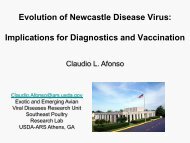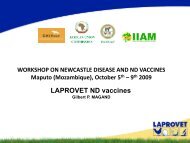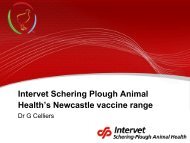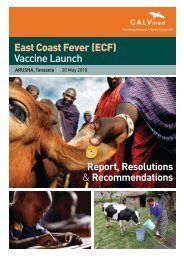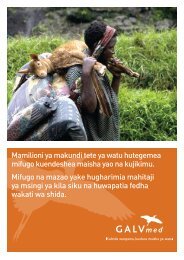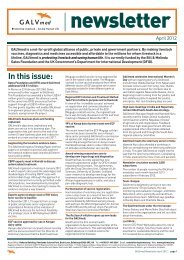A Path to Prosperity New Directions for African Livestock
GALVmed Impetus Strategy Paper
GALVmed Impetus Strategy Paper
- No tags were found...
Create successful ePaper yourself
Turn your PDF publications into a flip-book with our unique Google optimized e-Paper software.
The 2003 Avian Influenza crisis stirred FAO, WHO<br />
and OIE <strong>to</strong> strengthen their partnerships around a<br />
“One Health,” agenda. All commenta<strong>to</strong>rs agree this<br />
has been constructive and resulted in improved<br />
surveillance and response <strong>to</strong> emerging diseases,<br />
<strong>for</strong> example The Global Early Warning System<br />
<strong>for</strong> Major Animal Diseases, including Zoonoses<br />
(GLEWS) which has initially adopted a list of 25<br />
diseases of common interest, 76% of which are<br />
zoonotic 138 and the OIE/FAO Network of expertise<br />
on animal influenzas (OFFLU) implemented in<br />
close cooperation with WHO.<br />
In coming years the, OIE will collaborate with<br />
AU/IBAR <strong>to</strong> implement a programme <strong>for</strong> “rein<strong>for</strong>cing<br />
veterinary governance in Africa,” funded by the EC.<br />
This will build on PVS findings and will assist<br />
governments with policy analysis and <strong>for</strong>mulation,<br />
develop legal frameworks and integrate a wider<br />
group of stakeholders in decision making. This is<br />
a timely and important initiative as discussed<br />
in section 4 (animal health).<br />
International Fund <strong>for</strong> Agricultural<br />
Development – IFAD<br />
IFAD, a specialised UN agency, provides low-interest<br />
loans and grants <strong>to</strong> developing countries. Since<br />
starting operations in 1978, IFAD has invested<br />
US$11.5 billion in 838 projects and programmes that<br />
have reached some 350 million poor rural people<br />
and raised nearly double this amount through<br />
co-financing. Since 1978, US$738 million has been<br />
used <strong>for</strong> lives<strong>to</strong>ck development activities. Currently,<br />
IFAD spends just less than 9% of its budget on<br />
lives<strong>to</strong>ck-related projects. IFAD tackles poverty not<br />
only as a lender, but also as an advocate <strong>for</strong> rural<br />
poor people, using its multilateral base as a plat<strong>for</strong>m<br />
<strong>to</strong> discuss important policy issues that influence<br />
the lives of rural poor people. IFAD recently<br />
produced a flagship “Rural Poverty Report 2011,”<br />
that provides comprehensive analysis of rural<br />
poverty, its global consequences and the prospects<br />
<strong>for</strong> eradicating it 139 .<br />
Currently, almost 50% of IFADs funding goes <strong>to</strong><br />
Africa. As of the end of 2008, IFAD’s current portfolio<br />
of projects had trained just over one million people<br />
(65% of whom where women) in new lives<strong>to</strong>ck<br />
production practices/technologies. IFAD was one of<br />
the first UN agencies <strong>to</strong> undergo re<strong>for</strong>m, having<br />
closed many of its underper<strong>for</strong>ming projects, IFAD is<br />
now meeting and exceeding most of its own targets.<br />
It is expanding its country presence and has begun <strong>to</strong><br />
work more closely with the private sec<strong>to</strong>r through<br />
both grants and the promotion of private sec<strong>to</strong>r<br />
investment in rural areas. IFAD is acutely aware of<br />
the need <strong>to</strong> address challenges associated with<br />
climate change and supports smallholder farmers<br />
and rural entrepreneurs, particularly women,<br />
<strong>to</strong> engage in and influence relevant policy processes,<br />
including through South–South partnerships and<br />
knowledge-sharing among countries and regions 140 .<br />
IFAD’s lives<strong>to</strong>ck strategy shares the above approach.<br />
The lives<strong>to</strong>ck team in IFAD recently initiated a<br />
community of practice <strong>for</strong> pro-poor lives<strong>to</strong>ck<br />
development that provides a useful <strong>for</strong>um <strong>for</strong><br />
discussion and building links. The <strong>for</strong>um currently<br />
involves more than 150 organizations and 450<br />
resource people.<br />
The Food and Agriculture Organization<br />
of the United Nations (FAO)<br />
FAO’s great strength is that it assembles, in one<br />
organization, a larger number of professionals<br />
dealing with food and agriculture than any other<br />
international organization. FAO’s challenge is <strong>to</strong> get<br />
these professionals working across disciplines<br />
and focusing on areas where it has comparative<br />
advantage. The organisation benefited from a<br />
detailed independent external evaluation that<br />
provided significant advice on how <strong>to</strong> do this in 2007.<br />
Whilst it will take time <strong>for</strong> the recommendations of<br />
this evaluation <strong>to</strong> be adopted, the organisation has<br />
begun <strong>to</strong> take them on board. The work of the<br />
Animal Health and Production Division (AGA) was<br />
positively reviewed and the evaluation recommended<br />
significantly increased support <strong>to</strong> the lives<strong>to</strong>ck<br />
sec<strong>to</strong>r. This encouragement was recognition of the<br />
good work of AGA, particularly in the transboundary<br />
disease control and pro-poor lives<strong>to</strong>ck policy, the<br />
fact that FAO had been cutting the lives<strong>to</strong>ck budget<br />
<strong>for</strong> many years 13 and the fact that the lives<strong>to</strong>ck<br />
sec<strong>to</strong>r is growing rapidly in the developing world.<br />
AGA, like other divisions, has a wide remit, ranging<br />
from emergency response <strong>to</strong> production of guideline<br />
and best practice <strong>to</strong> sec<strong>to</strong>r analysis. AGA staff have<br />
proven <strong>to</strong> be especially useful in the <strong>for</strong>mulation<br />
of ideas contained in this Impetus paper.<br />
13 Falling by almost 40% as a proportion of the budget between 1994–05 and 2006–07.<br />
The Impetus Strategy Paper I Page 57



